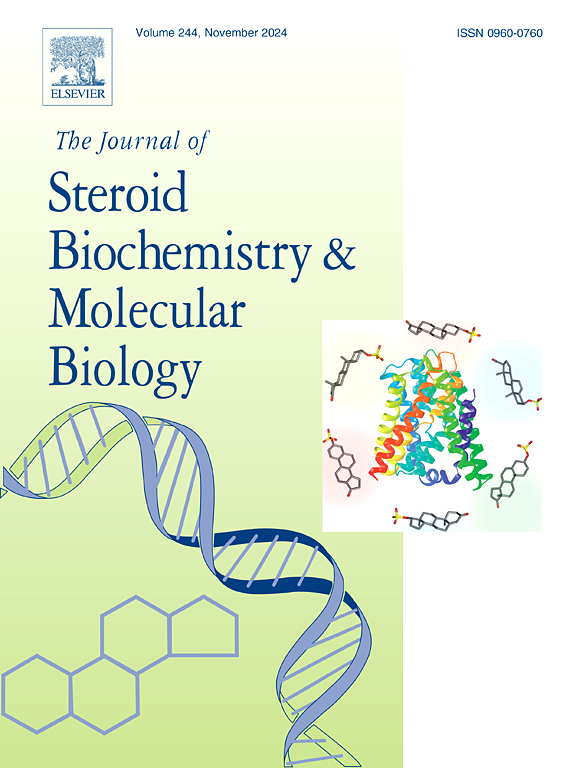A study of the role of androgen receptor and androgen receptor variant 7 in TNBC patients and the effect of their targeting by Enzalutamide and EPI-001 in MDA-MB-231
IF 2.7
2区 生物学
Q3 BIOCHEMISTRY & MOLECULAR BIOLOGY
Journal of Steroid Biochemistry and Molecular Biology
Pub Date : 2024-11-12
DOI:10.1016/j.jsbmb.2024.106636
引用次数: 0
Abstract
The lack of targeted therapy for triple-negative breast cancer (TNBC) is among the mainsprings of its poor prognosis. This study aimed to elucidate the role of the androgen receptor (AR) and its splice variant 7 (ARv7) in TNBC patients. Further, the molecular impact of their blockers, Enzalutamide and EPI-001, on the TNBC cell line MDA-MB-231 was investigated. Thereby, immunohistochemical expression of AR/ARv7 was assessed for TNBC Egyptian patients. Moreover, bioinformatics analysis of AR/ARv7 RNA status was carried out on TNBC patients from The Cancer Genome Atlas Breast Carcinoma project (TCGA-BRCA). Data from both groups was correlated with patients’ clinicopathological features. Besides, scratch wound healing assay and ELISA were employed to assess the effect of AR/ARv7 blockers on several metastasis markers in MDA-MB-231 cell line. In the Egyptian-TNBC patients, AR expression was associated with worse 7-year DFS (40.6 ± 18.6 %). In addition, ARv7 showed cytoplasmic and nuclear patterns, and both cytoplasmic and nuclear ARv7+ patients demonstrated a worse 7-year DFS (22.7 ± 17.7 % and 20 ± 17.9 %) and overall survival (63.6 ± 14.5 % and 40 ± 21.8 %). Importantly, 80 % of the nuclear ARv7+ patients developed distant metastasis. The data of the TCGA-TNBC patients showed a tendency for poor outcomes in the high ARv7-expressing patients. Molecularly, in MDA-MB-231, both inhibitors modulated metastasis and epithelial to mesenchymal transition (EMT) markers ROCK1, ROCK2, c-Myc, E-cadherin and N-cadherin, with EPI-001 downregulating NF-ĸB level as well. We concluded that ARv7 indicated poor prognosis in the studied cohorts and that blocking of AR/ARv7 abated metastasis and key regulators of EMT in MDA-MB-231, at least in part by targeting ROCK/NF-ĸB/c-Myc axis.
一项关于雄激素受体和雄激素受体变异体 7 在 TNBC 患者中的作用以及恩杂鲁胺和 EPI-001 在 MDA-MB-231 中靶向它们的效果的研究。
三阴性乳腺癌(TNBC)缺乏靶向治疗是其预后不良的主要原因之一。本研究旨在阐明雄激素受体(AR)及其剪接变体7(ARv7)在TNBC患者中的作用。此外,还研究了其阻断剂恩杂鲁胺和EPI-001对TNBC细胞系MDA-MB-231的分子影响。此外,还评估了TNBC埃及患者AR/ARv7的免疫组化表达。此外,还对癌症基因组图谱乳腺癌项目(TCGA-BRCA)中的 TNBC 患者进行了 AR/ARv7 RNA 状态的生物信息学分析。两组数据均与患者的临床病理特征相关。此外,还采用了划痕伤口愈合试验和酶联免疫吸附试验来评估AR/ARv7阻断剂对MDA-MB-231细胞系中几种转移标记物的影响。在埃及-TNBC患者中,AR表达与较差的7年DFS(40.6±18.6%)相关。此外,ARv7呈现细胞质和细胞核模式,细胞质和细胞核ARv7+患者的7年DFS(22.7±17.7%和20±17.9%)和总生存率(63.6±14.5%和40±21.8%)均较差。重要的是,80%的核ARv7+患者发生了远处转移。TCGA-TNBC患者的数据显示,ARv7高表达患者的预后倾向较差。分子方面,在MDA-MB-231中,两种抑制剂都能调节转移和上皮到间质转化(EMT)标志物ROCK1、ROCK2、c-Myc、E-钙粘蛋白和N-钙粘蛋白,EPI-001还能下调NF-ĸB水平。我们得出的结论是,ARv7表明研究组群的预后不佳,阻断AR/ARv7至少部分通过靶向ROCK/NF-ĸB/c-Myc轴,减轻了MDA-MB-231的转移和EMT的关键调节因子。
本文章由计算机程序翻译,如有差异,请以英文原文为准。
求助全文
约1分钟内获得全文
求助全文
来源期刊
CiteScore
8.60
自引率
2.40%
发文量
113
审稿时长
46 days
期刊介绍:
The Journal of Steroid Biochemistry and Molecular Biology is devoted to new experimental and theoretical developments in areas related to steroids including vitamin D, lipids and their metabolomics. The Journal publishes a variety of contributions, including original articles, general and focused reviews, and rapid communications (brief articles of particular interest and clear novelty). Selected cutting-edge topics will be addressed in Special Issues managed by Guest Editors. Special Issues will contain both commissioned reviews and original research papers to provide comprehensive coverage of specific topics, and all submissions will undergo rigorous peer-review prior to publication.

 求助内容:
求助内容: 应助结果提醒方式:
应助结果提醒方式:


